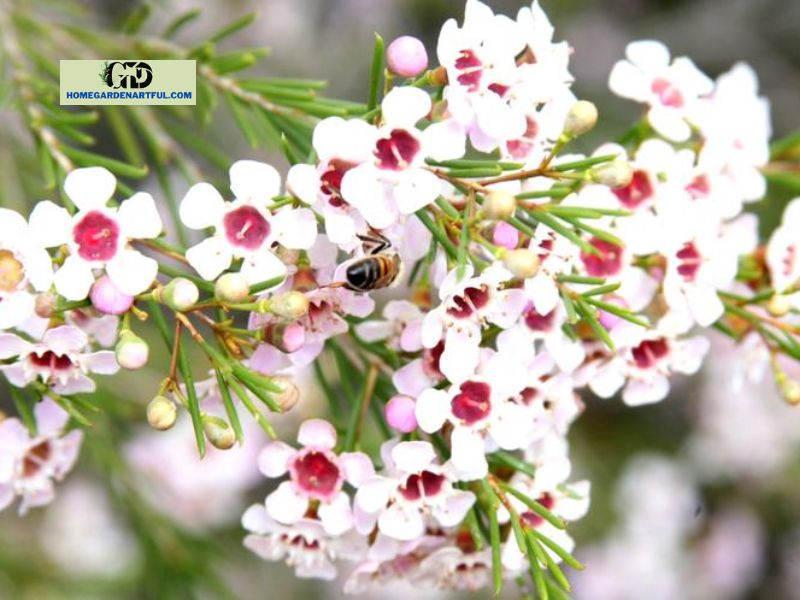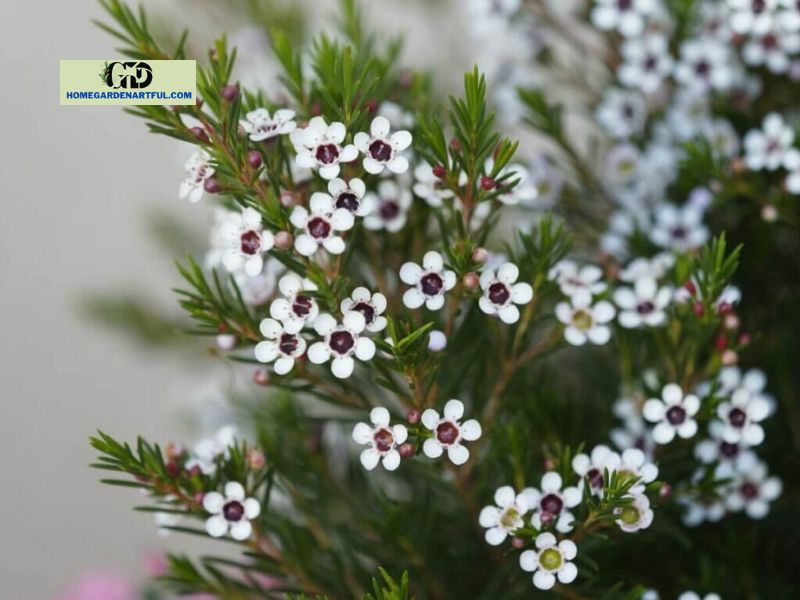Are you into White Wax Flower? The wax flower, known for its durable blossoms, is a favorite among florists. Its thin, slender leaves have a waxy texture.
Its alternate name, Geraldton wax, refers to the Western Australian town in which it can be found growing on heathland. The wax flower is a native of Australia. In the UK, it is not hardy enough to grow outside all year round, but given the correct conditions, it can thrive indoors or in a conservatory. Unpruned plants grow to a height of around 1.8 meters, but annual trimming can keep them lower. Discover at homegardenartful.com!
Growing White Wax Flower

The White Wax Flower has specific growing requirements, much like any other plant species. You must pay close attention to the unique requirements of each particular variety or cultivar to ensure optimal growth.
What you need to know is this:
Selecting the Correct Varieties
There are numerous cultivars of wax flowers, each with distinctive flower shapes and colors. Choose a kind that is appropriate for your preferences and climate there.
Prepare the soil
Improve the fertility and drainage of the soil before planting by adding organic material, such as compost or well-rotted manure. Sandal loam soil with good drainage is ideal for wax flowers.
Needs for Climate and Sunlight
White Wax flowers need lots of sunlight to grow well in subtropical and Mediterranean settings. To guarantee optimum development, pick a location in your garden that is sunny and has well-draining soil.
Planting Method
You have two possibilities for plant propagation: seeds or cuttings.
Gather mature seed capsules from the plant, then take the seeds out. Then plant them in a seed tray with a seed-raising mixture that drains nicely. Place the tray somewhere warm and bright, and make sure the soil is always moist. Once the seedlings are big enough to handle, transplant them into separate pots.
During the summer, remove 10-15 cm (4-6 inches) cuttings from strong, mature stems. Lower leaves should be removed before the cutting is planted in a well-draining potting mix. The cut end should then be dipped in rooting hormone. Make sure the pot is large enough—up to double the size of the root ball—if you plan to grow your waxflower in a container.
Caring for the Waxflower plant

White Wax Flower needs the right care to grow well. Here are some tips to assist you in taking care of your waxflower:
Waxflowers require regular watering throughout the first year of growth, but once established, they are generally drought-tolerant. Give the soil just enough water to make it moist, but don’t water too much because that can cause root rot.
Applying mulch will help the waxflower plant retain moisture, control weed growth, and maintain the proper soil temperature.
White Wax Flowers are accustomed to growing in low-nutrient soil, so they typically do not need heavy feeding. Early in the spring, apply a slow-release, balanced fertilizer to encourage strong growth. Avoid using fertilizers with high levels of phosphorus since they may cause excessive growth of foliage at the expense of flowering plants. Keep fertilizers organic and away from the plant’s base if you must use them.
Pruning: Regular, mild pruning keeps White Wax Flower healthy and in good form. Trim any damaged or dead branches after flowering, then lightly shape the plant. Avoid over-pruning, which might restrict flowering in succeeding seasons.
Repotting: Waxflower normally requires repotting every two to three years because it prefers to be slightly root-bound. To prevent excessive soil moisture, use a pot that is only marginally larger than the existing one and use a well-draining potting mixture.
Winter Protection: In colder climates, give your waxflowers winter protection. To protect the plant’s roots from frost and freezing conditions, spread a layer of mulch around the base of the plant.
Common Waxflower Problems

Waxflowers are typically hardy plants, although occasionally they can have issues. Here are a few typical problems that could occur with waxflowers:
- Root Rot: Root rot, which is characterized by drooping, yellowing leaves, and a bad odor, can be caused by excessive watering or poor drainage. Make sure the soil has good drainage and let the top inch of soil dry out between waterings to prevent root rot. If you see indications of too much moisture, adjust your watering plan accordingly.
- Alternaria: Alternaria appears on the leaves as dark, rounded, or asymmetrical patches that can expand and coalesce, resulting in browning or yellowing. Remove and dispose of diseased plant material, enhance air circulation, reduce overhead watering, provide appropriate sunlight, maintain cleanliness, and think about applying fungicides if necessary in order to control and prevent this problem.
- Leaf Spot: Leaf spot infections, which result in black patches or lesions on the leaves, can harm waxflowers. High humidity or water splashing on the leaves are two common causes of this problem. Avoid overhead watering and make sure there is adequate air circulation around the plant to prevent leaf spots. Removing the afflicted leaves and thinking about using a fungicide designed specifically for attractive plants should be done if a leaf spot is seen.
- Aphids: Aphids are tiny, sap-eating insects that are drawn to waxflowers and can cause leaf curling, deformation, and the buildup of a sticky substance known as honeydew. Use insecticidal soap, neem oil, or a strong stream of water to spray the plant to flush out aphids. Stronger chemical treatments might be necessary for persistent infestations.
- Spider mites: These minuscule pests can cause waxflowers to develop stunted growth, fine webbing, and fading foliage. Spider mites prefer dry environments, so elevating the humidity and spraying the plant frequently can help keep them away. If an infestation develops, spray water on the plant, paying specific attention to the undersides of the leaves, or use a suitable miticide in accordance with the product’s instructions.
- Lack of blossoms: Lack of waxflower blossoms may be caused by inadequate light or incorrect trimming. Make sure your plant gets adequate bright, indirect light, and refrain from severe pruning when it is in bloom. A balanced plant meal applied correctly to the soil can help encourage good blossoming.
Conclusion
White Wax Flowers are exciting and satisfying to grow and care for. Just keep in mind to choose the suitable types, offer enough sunlight and nutrient-rich soil, and follow a reasonable watering and fertilizing schedule. Your waxflowers will stay healthy and vibrant if you prune and control pests on a regular basis. Their lovely waxy flowers and aromatic foliage will soon give your landscape a refined and charming touch.


